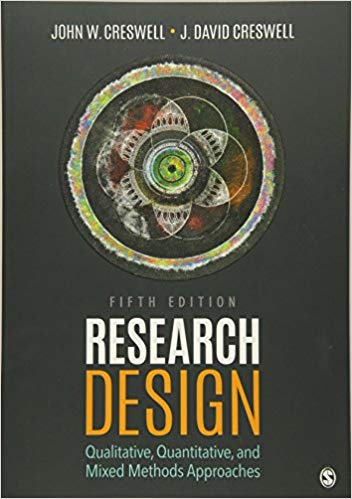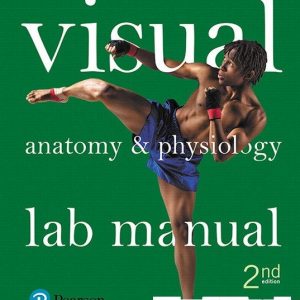Test Bank for Research Design Qualitative, Quantitative, and Mixed Methods Approaches 5th by Creswell

Product details:
- ISBN-10 : 1506386709
- ISBN-13 : 978-1506386706
- Author: John W. Creswell, PhD
This bestselling text pioneered the comparison of qualitative, quantitative, and mixed methods research design. For all three approaches, John W. Creswell and new co author J. David Creswell include a preliminary consideration of philosophical assumptions; key elements of the research process; a review of the literature; an assessment of the use of theory in research applications, and reflections about the importance of writing and ethics in scholarly inquiry.
Table contents:
Part I Preliminary Considerations 1
Chapter 1 The Selection of a Research Approach 3
Learning Objectives 3
Introducing Key Terms in this Chapter 3
Three Approaches or Methodologies in Research 4
Three Major Components of a Research Approach 6
Philosophical Worldviews 6
The Postpositivist Worldview 7
The Construciivist Worldview 9
The Transformative Worldview 10
The Pragmatic Worldview 11
Research Designs 13
Quantitative Designs 13
Qualitative Designs 14
Mixed Methods Designs 15
Research Methods 17
Interconnecting Worldviews, Designs, and Methods 18
Criteria for Selecting a Research Approach 20
The Research Problem and Questions 20
Personal Experiences 21
Audience 22
Summary 22
Key Terms 22
Writing Exercises 23
Additional Readings 23
Chapter 2 Review of the Literature 25
Learning Objectives 25
Introduction 25
The Research Topic 26
A Draft Title 26
A Significant Topic 27
The Purpose and Organization of a Literature Review 28
Purpose of a Literature Review 28
The Organization of the Literature Review 29
General Forms 29
A Qualitative Structure 29
A Quantitative Structure 31
A Mixed Methods Structure 32
Steps in Conducting a Literature Review 32
Searching the Literature 34
Computer Databases 34
Types of Literature 36
Priority of the Literature 36
Overall Evaluation Quality 37
Abstracting the Literature 37
Components of an Abstract 38
Theoretical, Conceptual, and Methodological Abstracts 38
A Literature Map 39
Example 2.1 Components of a Methodological Journal Article Abstract 39
Style Manual Use 43
The Definition of Terms 44
General Guidelines 45
Special Terms 46
Example 2.2 Defining Terms in a Dissertation 47
Summary 47
Key Terms 48
Writing Exercises 48
Additional Readings 49
Chapter 3 The Use of Theory 51
Learning Objectives 51
Introduction 51
The Varied Use of Theory 52
Quantitative Theory Use 53
Definition of a Theory in Quantitative Research 53
Variables in Quantitative Research 54
Testing Causal Claims in Quantitative Research 56
Stating Theories in Quantitative Research 57
Placement of Quantitative Theories 60
Writing a Quantitative
Theoretical Perspective 60
Example 3.1 A Quantitative Theory Section 63
Qualitative Theory Use 64
Variation in Theory Use in Qualitative Research 65
Locating the Theory in Qualitative Research 68
Example 3.2 A Theory Early in a Qualitative Study 68
Example 3.3 Theory at the End of a Qualitative Study 69
Mixed Methods Theory Use 69
Types of Mixed Methods Theory Use 69
Importance of a Theory 71
Distinctions Between a Theory and a Worldview 72
A Theoretically Driven Mixed Methods Study 72
What Theory Informs 73
Example 3.4 A Discipline-Based Theory in a Mixed Methods Study 74
Summary 74
Key Terms 75
Writing Exercises 76
Additional Readings 76
Chapter 4 Writing Strategies and Ethical Considerations 79
Learning Objectives 79
Introduction 79
Writing the Proposal 79
Topics Presented in a Proposal 80
A Qualitative Proposal 80
A Qualitative Constructivist or Interpretivist Format 81
A Quantitative Proposal 81
Example 4.2 A Qualitative Participatory or Social Justice Format 82
Example 4.3 A Quantitative Format 82
A Mixed Methods Proposal 83
Example 4.4 A Mixed Methods Format 83
Designing the Sections of a Proposal 84
Writing Strategies 84
The Process 84
The Habit of Writing 85
Clear and Concise Writing 87
Coherence 88
Voice, Tense, and “Fat” 91
Ethical Issues 93
Prior to Beginning the Study 95
Beginning the Study 97
Collecting the Data 98
Analyzing the Data 99
Reporting, Sharing, and Storing Data 100
Summary 102
Key Terms 102
Writing Exercises 102
Additional Readings 103
Part II Designing Research 105
Chapter 5 The Introduction 107
Learning Objectives 107
Introduction to a Study 107
The Importance of Introductions 108
An Abstract for a Study 109
Qualitative, Quantitative, and Mixed Methods Introductions 110
A Model for an Introduction 111
An Illustration of an Introduction 112
The Research Problem 112
Evidence From the Literature Justifying the Problem 115
Deficiencies in the Evidence 117
Example 5.1 Deficiencies in the Literature-Needed Studies 117
Example 5.2 Deficiencies in the Literature-Few Studies 118
Importance of the Problem for Audiences 118
Example 5.3 Significance of the Study Stated in an Introduction to a Quantitative Study 119
Summary 119
Key Terms 119
Writing Exercises 120
Additional Readings 120
Chapter 6 The Purpose Statement 123
Learning Objectives 123
Introduction 123
Significance of a Purpose (or Study Aim) Statement 124
A Qualitative Purpose Statement 125
Example 6.1 A Purpose Statement in a Qualitative Phenomenology Study 127
Example 6.2 A Purpose Statement in a Qualitative Case Study 128
Example 6.3 A Purpose Statement in a Narrative Study 129
Example 6.4 A Purpose Statement in a Grounded Theory Study 129
A Quantitative Purpose Statement 130
Example 6.5 A Purpose Statement in a Survey Study 132
Example 6.6 A Purpose Statement in a Dissertation Survey Study 132
Example 6.7 A Purpose Statement in an Experimental Study 133
A Mixed Methods Purpose Statement 134
Example 6.8 A Convergent Mixed Methods Purpose Statement 137
Example 6.9 An Explanatory Sequential Mixed Methods Purpose Statement 138
Example 6.10 An Exploratory Sequential Mixed Methods Purpose Statement 139
Summary 140
Key Terms 140
Writing Exercises 141
Additional Readings 141
Chapter 7 Research Questions and Hypotheses 143
Learning Objectives 143
Introduction 143
Quantitative Research Questions and Hypotheses 144
Example 7.1 Script for a Descriptive Quantitative Research Question 145
Example 7.2 Script for a Relationship-Oriented Quantitative Research Question and Directional Hypothesis 145
Example 7.3 Example of Quantitative Directional Hypotheses 146
Qualitative Research Questions 146
Example 7.4 A Qualitative Central Question in an Ethnography 149
Example 7.5 Qualitative Central Questions in a Case Study 149
Example 7.6 Qualitative Sub-Questions 150
Mixed Methods Research Questions and Hypotheses 150
Example 7.7 Statement of Objectives in a Mixed Methods Study 152
Example 7.8 Research Questions in a Mixed Methods Study 153
Summary 154
Key Terms 154
Writing Exercises 154
Additional Readings 155
Chapter 8 Quantitative Methods 157
Learning Objectives 157
Introduction 157
Putting Quantitative Research in Context 158
Quantitative Desrgns 158
Components of a Survey Study Method Plan 159
The Survey Design 161
The Purpose 161
Rationale for Using the Survey Method 161
Type of Survey Method 161
Specify the Form of Data Collection 161
The Population and Sample 162
The Population 162
Sampling Design 162
Type of Sampling 162
Population Stratification 163
Sample Size Determination 163
Power Analysis 163
Instrumentation 163
The Survey Instruments Used to Collect Data 164
Instruments and Measures 164
Validity of Scores Using the Instrument 164
Reliability of Scores on the Instrument 165
Inter-Rater Reliability 165
Sample Items 165
Content of an Instrument 165
Pilot Testing 166
Administering the Survey 166
Variables in the Study 166
Data Analysis 167
Preregistering the Study Plan 169
Interpreting Results and Writing a Discussion Section 170
Reporting Results 170
Statistical Tests in Survey Research 170
Practical Evidence 172
Context of Previous Studies 172
Components of an Experimental Study Method Plan 172
Participants 173
Recruiting Participants 173
Random Assignment 174
Power Analysis for Sample Size 174
Formal Design Statement 174
Variables 175
Independent Variables 175
Manipulation Check 175
Dependent Variables 175
Otter Variables 175
Instrumentation and Materials 176
Materials 176
Cover Story 176
Experimental Procedures 176
Type of Experiment 177
Example 8.1 Pre-Experimental Designs 178
Example 8.2 Quasi-Experimental Designs 179
Example 8.3 True Experimental Designs 179
Example 8.4 Single-Subject Designs 180
Threats to Validity 180
Internal Validity 180
External Validity 182
The Procedure 182
Data Analysis 184
Reporting the Descriptive Statistics 184
Preliminary Analysis 184
Inferential Statistical Tests 184
Factorial Designs 184
Single-Subject Designs 185
Preregistering the Study Plan 185
Interpreting Results and Writing a Discussion Section 185
Example 8.5 An Experimental Method Plan 186
Summary 187
Key Terms 187
Writing Exercises 187
Additional Readings 188
Chapter 9 Qualitative Methods 191
Learning Objectives 191
Introduction 191
Putting Qualitative Research Into Context 192
Participants’ Meanings 193
Natural Setting 193
Researcher as Key Instrument 193
Multiple Sources of Data 193
Inductive and Deductive Data Analysis 194
Emergent Design 194
Reflexivity 194
Researcher’s Role 195
A Complex Account 195
The Approach or Design 195
Descriptive Methods 196
Analytic Frameworks 196
Data Collection Procedures 198
Sampling and Recruitment 198
Permissions 199
Data Collection Types 199
Ethical Issues 201
Data Recording Procedures 202
Observation Protocol or Guide 203
Interview Protocol 203
Data Analysis Procedures 205
Simultaneous Procedures 205
Winnowing the Data 206
Using Qualitative Computer Software Programs 206
Steps in the Analytic Process 207
Step 1 Organizing and Preparing the Data for Analysis 207
Step 2 Reading Through All the Data 207
Step 3 Coding the Data 207
Step 4 Identifying Themes 207
Step 5 Developing a Story Line Interpretation 209
Step 6 Further Analyzing the Data Using an Analytic Framework 209
Step 7 Representing and Interpreting the Data 209
Coding the Data 209
Expected Codes 210
Surprising Codes 210
Codes of Unusual or Conceptual Interest 211
Predetermined Codes 211
Visual Images as Codes 211
Interpretation 212
Validity and Reliability 212
Defining Qualitative Validity 213
Validity Strategies 213
Reliability Strategies 215
Intercoder Agreement 215
Qualitative Generalization 215
Writing the Qualitative Report 216
Writing Strategies 216
A Sample Qualitative Method Section 217
The Qualitative Research Paradigm 217
The Ethnographic Research Design 218
The Researcher’s Role 219
Bounding the Study 219
Setting 219
Actors 220
Events 220
People also search:
qualitative inquiry and research design 5th edition
research design qualitative quantitative and mixed methods approaches 5th
5 types of qualitative research design
what are the 4 types of research design qualitative





